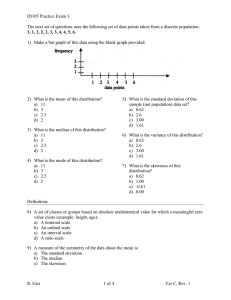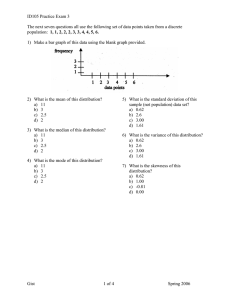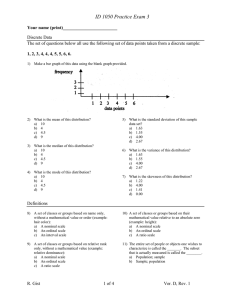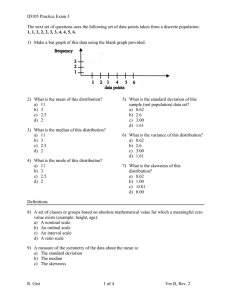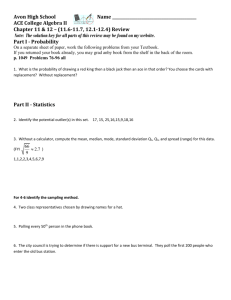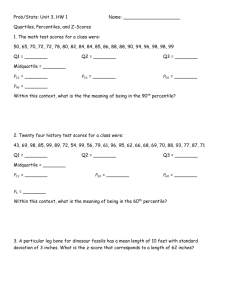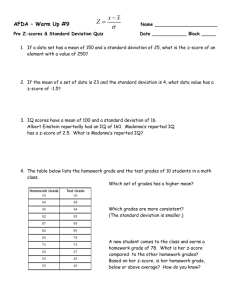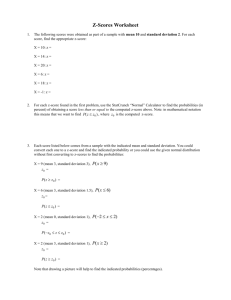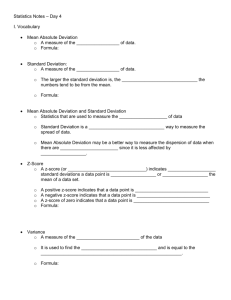ID 1050 Practice Exam 3
advertisement
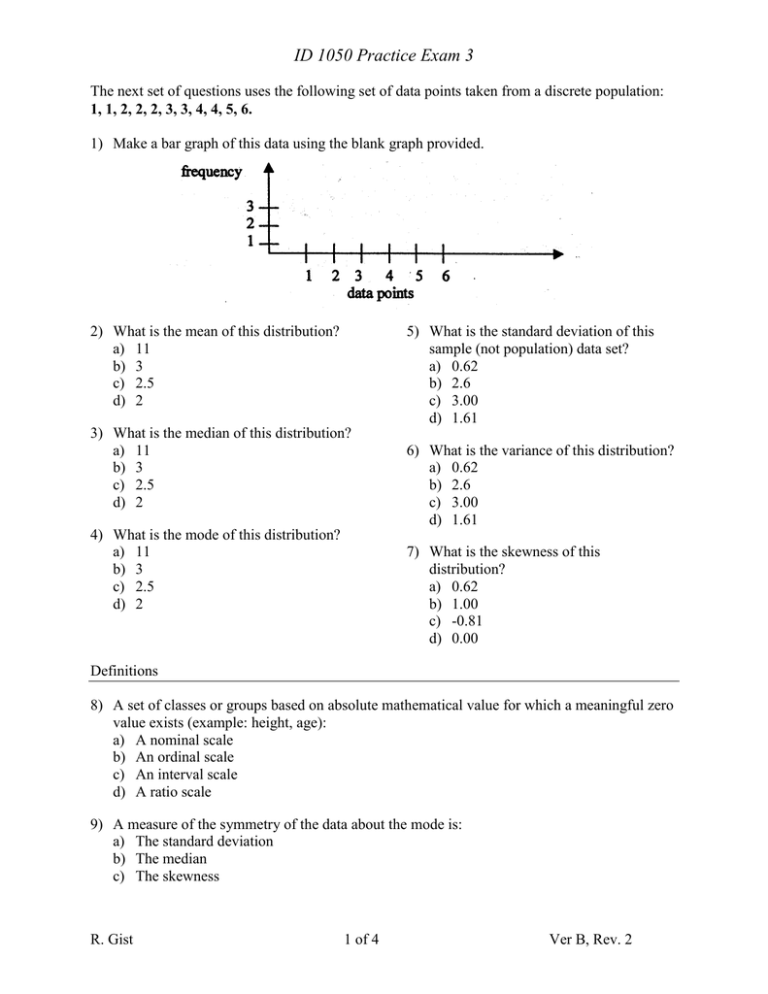
ID 1050 Practice Exam 3 The next set of questions uses the following set of data points taken from a discrete population: 1, 1, 2, 2, 2, 3, 3, 4, 4, 5, 6. 1) Make a bar graph of this data using the blank graph provided. 2) What is the mean of this distribution? a) 11 b) 3 c) 2.5 d) 2 5) What is the standard deviation of this sample (not population) data set? a) 0.62 b) 2.6 c) 3.00 d) 1.61 3) What is the median of this distribution? a) 11 b) 3 c) 2.5 d) 2 4) What is the mode of this distribution? a) 11 b) 3 c) 2.5 d) 2 6) What is the variance of this distribution? a) 0.62 b) 2.6 c) 3.00 d) 1.61 7) What is the skewness of this distribution? a) 0.62 b) 1.00 c) -0.81 d) 0.00 Definitions 8) A set of classes or groups based on absolute mathematical value for which a meaningful zero value exists (example: height, age): a) A nominal scale b) An ordinal scale c) An interval scale d) A ratio scale 9) A measure of the symmetry of the data about the mode is: a) The standard deviation b) The median c) The skewness R. Gist 1 of 4 Ver B, Rev. 2 ID1050 Practice Exam 3 The next set of questions is taken from the following set of data which comes from a population which is continuously distributed: 1.3, 1.9, 2.1, 3.1, 3.8, 3.8, 4.4, 4.5, 5.1, 5.3 10) Draw a histogram of this data. Use the number of classes and the class width that is shown on the following blank graph: 11) What is the mean of this data? a) 3.50 b) 3.80 c) 3.45 d) 3.53 14) What is the standard deviation of this sample (not population) data set? a) 1.50 b) 1.55 c) 1.92 d) 1.39 12) What is the median of this data? a) 3.50 b) 3.80 c) 3.45 d) 3.53 15) What is the variance of this data? a) 1.50 b) 1.55 c) 1.92 d) 1.39 13) What is the mode of this data? a) 3.50 b) 3.80 c) 3.45 d) 3.53 R. Gist 16) What is the skewness of this data? a) 1.50 b) -4.10 c) 0.022 d) -1.75 2 of 4 Ver B, Rev. 2 ID1050 Practice Exam 3 The next set of questions is based on the following normal curve. The curve below represents the results of a large population on a particular exam. The mean on the exam was 70 (=70). The standard deviation on the exam was 5 (=5). Use the percentages given here. 17) Chuck scores 80. What percentage of all people taking this test will score higher than Chuck? a) 0.5% b) 2.5% c) 16% d) 84% 20) What is the highest grade someone else could have and still be in the bottom 50% of everyone taking the exam? a) 65 b) 70 c) 75 d) 80 18) Using Chuck as an example, you can say that his grade lies at the ______ percentile. a) 2.5 th b) 16 th c) 84 th d) 97.5 th 21) What percentage of all people taking the exam scored at least a 60? a) 2.5% b) 16% c) 84% d) 97.5% 19) What is the lowest grade someone else could have and still be in the top 16% of all people taking the exam? a) 60 b) 65 c) 70 d) 75 R. Gist 3 of 4 22) What percentage of all people taking the exam scored between 60 and 80? a) 47.5% b) 95% c) 68% d) 81.5% Ver B, Rev. 2 ID1050 Practice Exam 3 The next set of questions is based on normally distributed (fictional) data. The population represents the household incomes in the state of Colorado. The average income was $50,000 (=50000). The standard deviation of incomes was $10000 (=10000). Using the z-score table provided, answer the following: 23) What percentage of the population earned less than $50000? a) 40 % b) 45 % c) 50 % d) 60 % 26) What percentage of the population earned less than $35000? a) 6.7 % b) 19.2 % c) 50 % d) 75.6 % 24) What percentage of the population earned more than $55000? a) 10.4% b) 30.9 % c) 50 % d) 68.8 % 27) What percentage of the population earned between the average income and $55000? a) 40 % b) 30.8 % c) 27.5 % d) 19.2 % 25) If the population represented was 1.5 million households, how many households earned more than $55000? a) 1 million b) 0.84 million c) 0.46 million d) 0.15 million 28) What percentage of the population earned between $35000 and $55000? a) 6.7 % b) 19.2 % c) 50 % d) 62.5 % ____________________________________________________________________________ Z-Score Table (A) z-score 0.0 0.1 0.2 0.3 0.4 0.5 0.6 0.7 0.8 0.9 1.0 1.1 1.2 1.3 1.4 1.5 R. Gist (B) Area between z and the mean 0.000 0.040 0.079 0.118 0.155 0.192 0.226 0.258 0.288 0.316 0.341 0.364 0.385 0.403 0.419 0.433 (C) Area beyond z 0.500 0.460 0.421 0.382 0.345 0.309 0.274 0.242 0.212 0.184 0.159 0.136 0.115 0.097 0.081 0.067 (A) z-score 1.6 1.7 1.8 1.9 2.0 2.1 2.2 2.3 2.4 2.5 2.6 2.7 2.8 2.9 3.0 4 of 4 (B) Area between z and the mean 0.445 0.455 0.464 0.471 0.477 0.482 0.486 0.489 0.492 0.494 0.495 0.496 0.497 0.498 0.499 (C) Area beyond z 0.055 0.045 0.036 0.029 0.023 0.018 0.014 0.011 0.008 0.006 0.005 0.004 0.003 0.002 0.001 Ver B, Rev. 2
